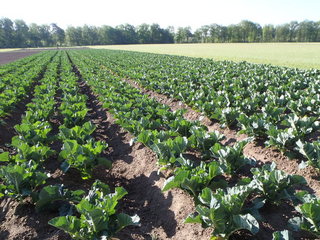
Breeding
Breeding is in fact developing new varieties. There still are few varieties that have been developed specifically for biological(-dynamical) purposes. The regular way of breeding aims at more yield and disease-resistance. Biological breeding aims at improving fieldtolerance against diseases, nourishing qualities and taste.
On our fields we are currently working on four types of crops:
- Beetroot: further development of a beetroot that is sold in shops in bundles. It is important here that small plants soon produce a harvestable little beet whereby the quantity of foliage is not too great.
A second project consists of developing a low-nitrate level beetroot for industrial purposes (babyfood and juice). - Onion: here we worked intensively on an earlyripening yellow seed-onion that has a good quality for storing. After two years of assessment by the “Bundes-Sorten-Amt” (Federal Plantvarieties Office of Germany) in 2014 our candidate is acknowledged as a new variety, named: Prometa.
Another project is the screening of many varieties on tolerance against Downy MILDEW (peronospora destructor). This we do in cooperation with the Vavilov Institute in St. Petersburg, Russia. This Institute has the most extensive seed collection of cultivated crops in the world. - Carrot: here the focus is on developing a carrot that can be stored well, has a good taste and does well on sandy soil.
- Cauliflower: on four Kultursaat-locations including De Groenen Hof an intensive selectionprogram is under way in the framework of the Naturata ( Luxemburg wholesale dealer) Fair-Breeding® project. The intention is to in a fairly short time bring good open polllinated seedvarieties on the market. For the time being the focus is on varieties that are suitable for cultivation in autumn. Meanwhile two new varieties are available (Tabiro and Nuage). Our method of selection consists of positive mass-selection together with line-selection:
Positive mass-selection: from a great group of plants the best are selected. These elite plants are allowed to go to seed and so constitute the basis for the next generation. By doing this from generation to generation the population is developed in the desired direction.
Line-selections: here seed of the selected plants is harvested separately. By doing so one obtains groups of offspring so to say (lines). The next year these are to be planted out separately next to eachother. Out of the best lines ( many lines are discarded as a whole) the best individuai plants are selected and together brought to flower and seed as a community. By flowering in a community part of the selectionprogress may get diluted, but more important is to so prevent a dip on account of innbreeding.

It becomes clear from the abovesaid that all selection in principle takes place on plantlevel. (as opposed to selection on cell level or DNA level in conventional breeding). The focus in our selection is on the interaction between plant and its surroundings. And this from generation to generation. In this connection it is important to note that we are reluctant to cross varieties with others. The important reason is qualities that many self pollinating varieties carry a fairly wide bandwith for many properties, i.e there is ample variety to select from.
Crossbreeding is easily done, to then form a stable population often takes 7 generations (14 years). Only when the quality desired for is not or unsufficiently available in the variety in which selection takes place, a crossing with another variety that holds the quality wished for –and is further of no interest- can be considered.


 winkelmandje
winkelmandje